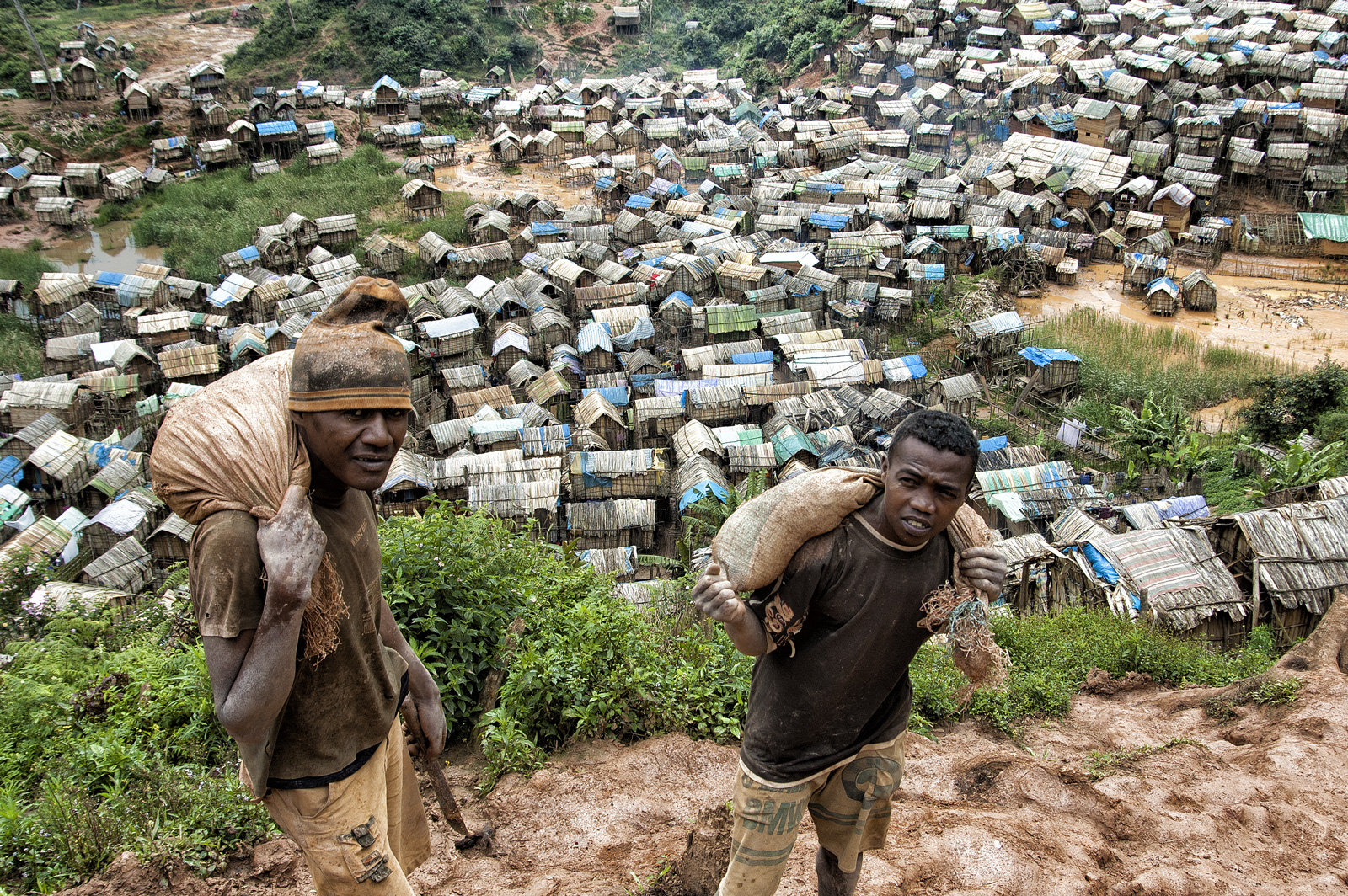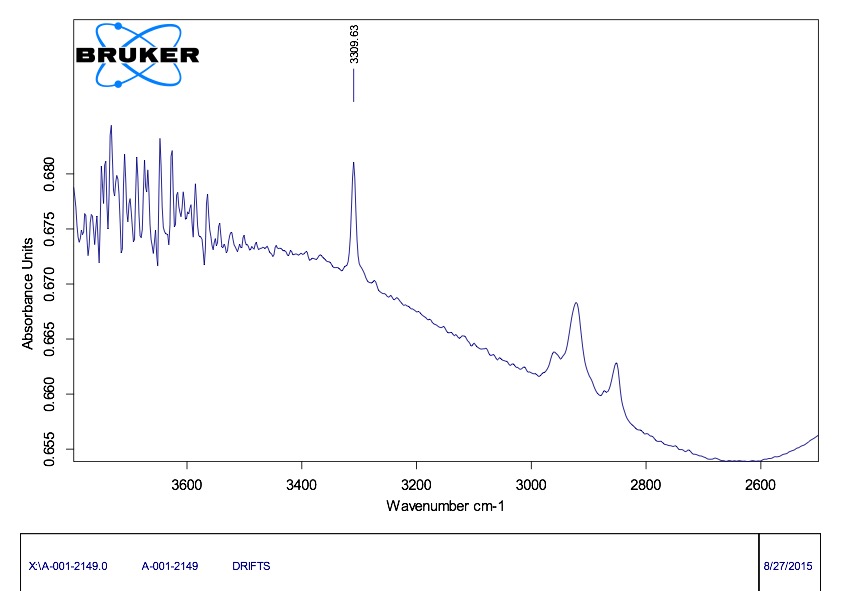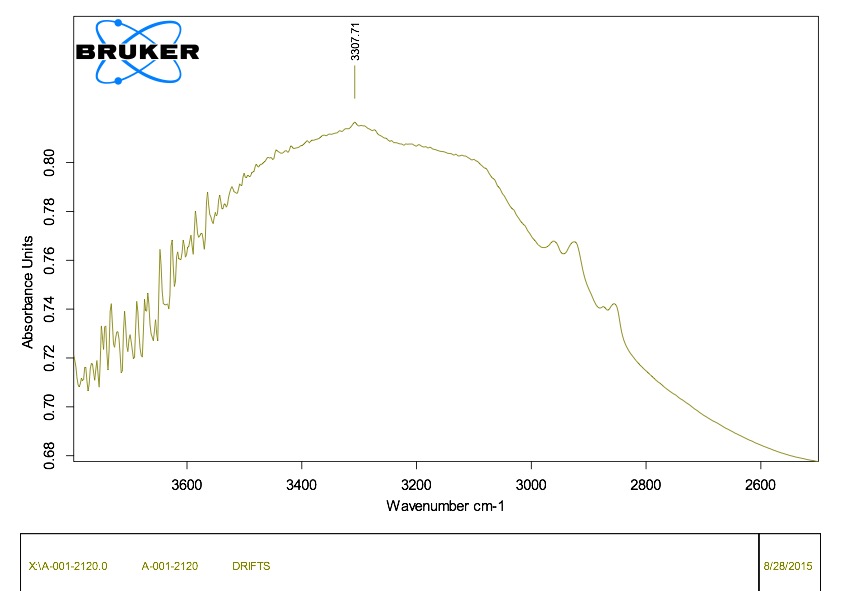When it rains red, it doesn't simply pour. It bleeds. Following closely on the heels of the ruby strikes in Mozambique, a major new find of the crimson stone is made in Madagascar.
Hello, My Old Friend
2 Sept. 2015 (updated 28 Sept. 2015) – Recently, a close friend of ours gave us a heads-up about a new ruby mine in Madagascar, sending a photo that showed several pieces of gemmy blood-red ruby rough sitting atop a small scale. Word had it that the Madagascar bush had yielded up yet another piece of crystallized treasure, this twist on terra firma in the form of blood-red ruby. Today rumor became reality. A client walked in with a few dozen faceted rubies. As always, we asked for the source. "Mozambique" was the reply. Ho hum. Until I scoped the first piece.
Have you ever met someone briefly, and then, after a long period, you glance at a face and think to yourself: "Something's familiar. I think I know you from somewhere." Gazing into the microscope brought back vivid memories of an epic 2005 visit to Moramanga, aka "Sierra Leone," a mine deep in the Madagascar bush. Yes, we had met before.
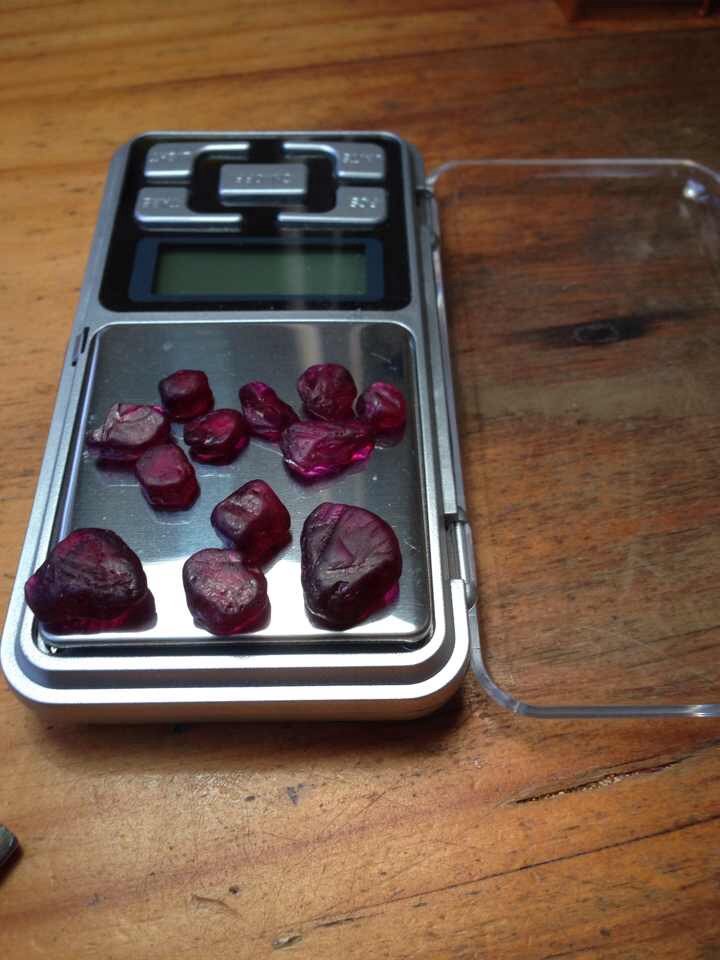 Rough ruby said to be from the new (2015) find south of Andilamena, Madagascar. Two weeks after receiving this photo from a friend, cut stones began arriving at Lotus Gemology's Bangkok office.
Rough ruby said to be from the new (2015) find south of Andilamena, Madagascar. Two weeks after receiving this photo from a friend, cut stones began arriving at Lotus Gemology's Bangkok office.
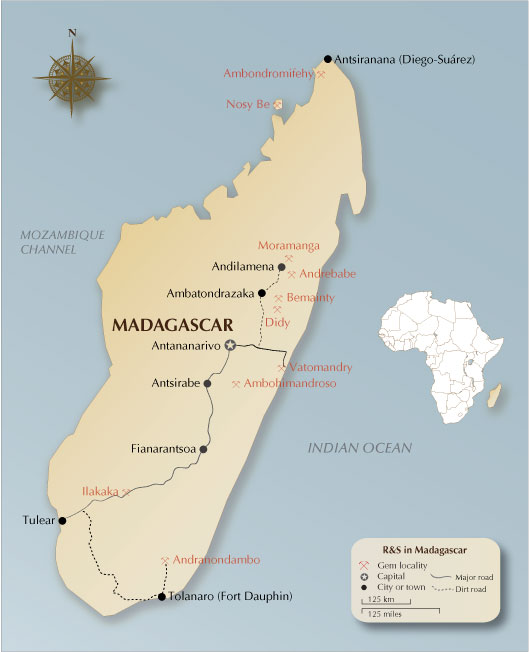 Map of Madagascar showing the major ruby and sapphire localities. The new ruby find is thought to be south of Andilamena, at Ambodivoahangy, in Zahamena National Park. Map: R.W. Hughes/Lotus Gemology.
Map of Madagascar showing the major ruby and sapphire localities. The new ruby find is thought to be south of Andilamena, at Ambodivoahangy, in Zahamena National Park. Map: R.W. Hughes/Lotus Gemology.
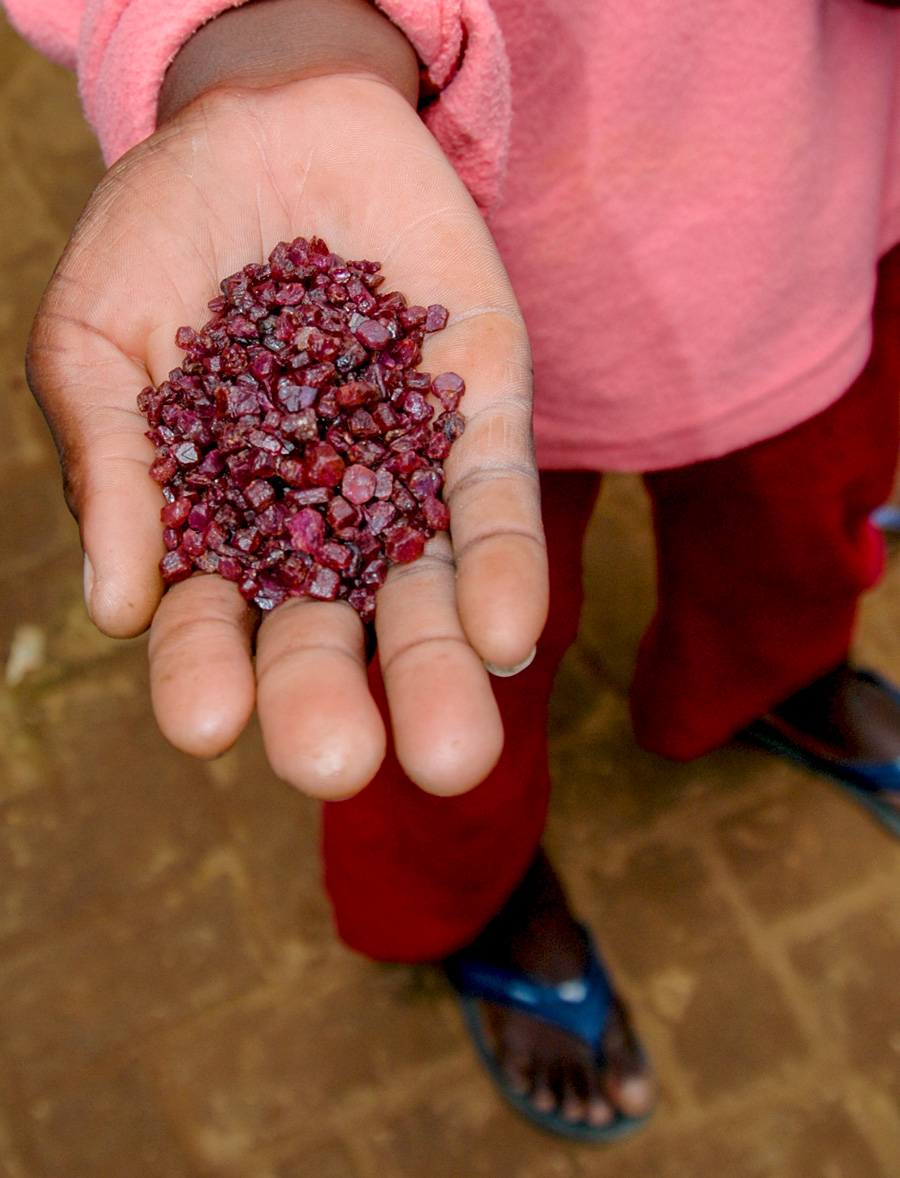 Ruby from Moramanga on offer in the market at Andilamena, Madagascar in September 2005. Photo: R.W. Hughes.
Ruby from Moramanga on offer in the market at Andilamena, Madagascar in September 2005. Photo: R.W. Hughes.
The New Rubies
A quick examination of the new rubies reveal features quite similar to the stones I had collected at Moramanga in September 2005. With one major difference. These rubies were much bigger. And much better. No more the poor stepchild of the ruby world, suitable only for glass filling. These rubies could strut their stuff completely and unabashedly au naturel, no silica implants needed.
Like the Moramanga rubies of old, these new stones come in two subtly different flavors. Many stones are a vivid "blood red," falling into the Lotus Gemology "Royal Red" color type (See 'From Peacock to Pigeon's Blood' for more on Lotus color types). Others are one level down in saturation. Superficially, many of these stones will be confused with the darker varieties of Mozambique ruby. Thankfully, microscopic examination can easily separate them.
Stone sizes were, for ruby, excellent. The lot we examined consisted of faceted gems ranging from 1.04 to 7.16 ct, with many being larger than three carats.
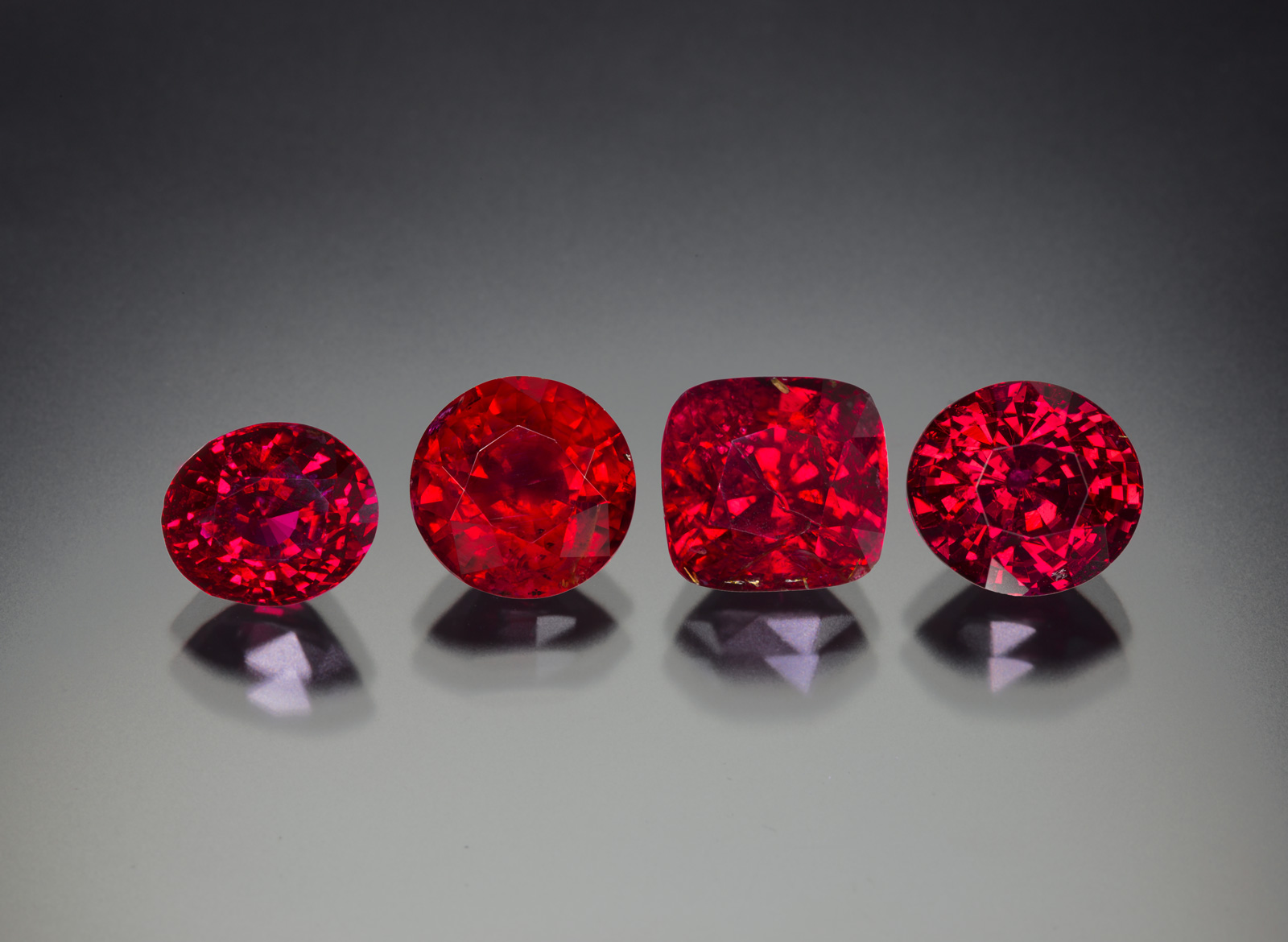 Four untreated rubies from the new find in Madagascar, ranging in size from 4.0 to 6.5 ct. As can be seen, the new production is extremely gemmy. Most gems fell into the Lotus Gemology "Royal Red" color type. Photo: Wimon Manorotkul/Lotus Gemology; rubies courtesy of Zahran International.
Four untreated rubies from the new find in Madagascar, ranging in size from 4.0 to 6.5 ct. As can be seen, the new production is extremely gemmy. Most gems fell into the Lotus Gemology "Royal Red" color type. Photo: Wimon Manorotkul/Lotus Gemology; rubies courtesy of Zahran International.
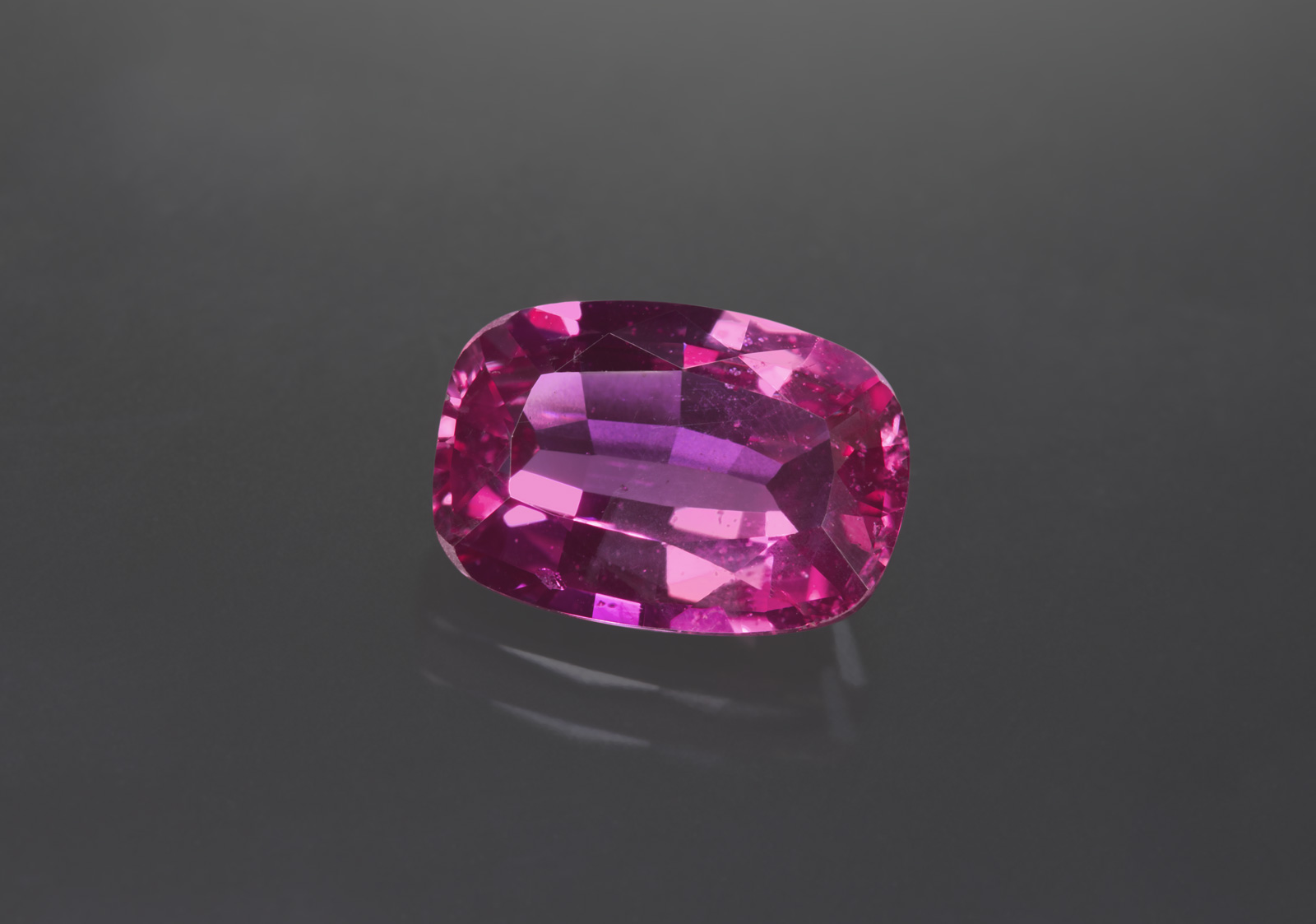 This six-carat ruby is an example of the more open color that is also found at the deposit. Photo: Wimon Manorotkul/Lotus Gemology; gem: Daniel Sherf/Shoham.
This six-carat ruby is an example of the more open color that is also found at the deposit. Photo: Wimon Manorotkul/Lotus Gemology; gem: Daniel Sherf/Shoham.
Microscopic Features
The microscopic features of these new Madagascar rubies are quite distinctive and allow ready separation from rubies from other sources.
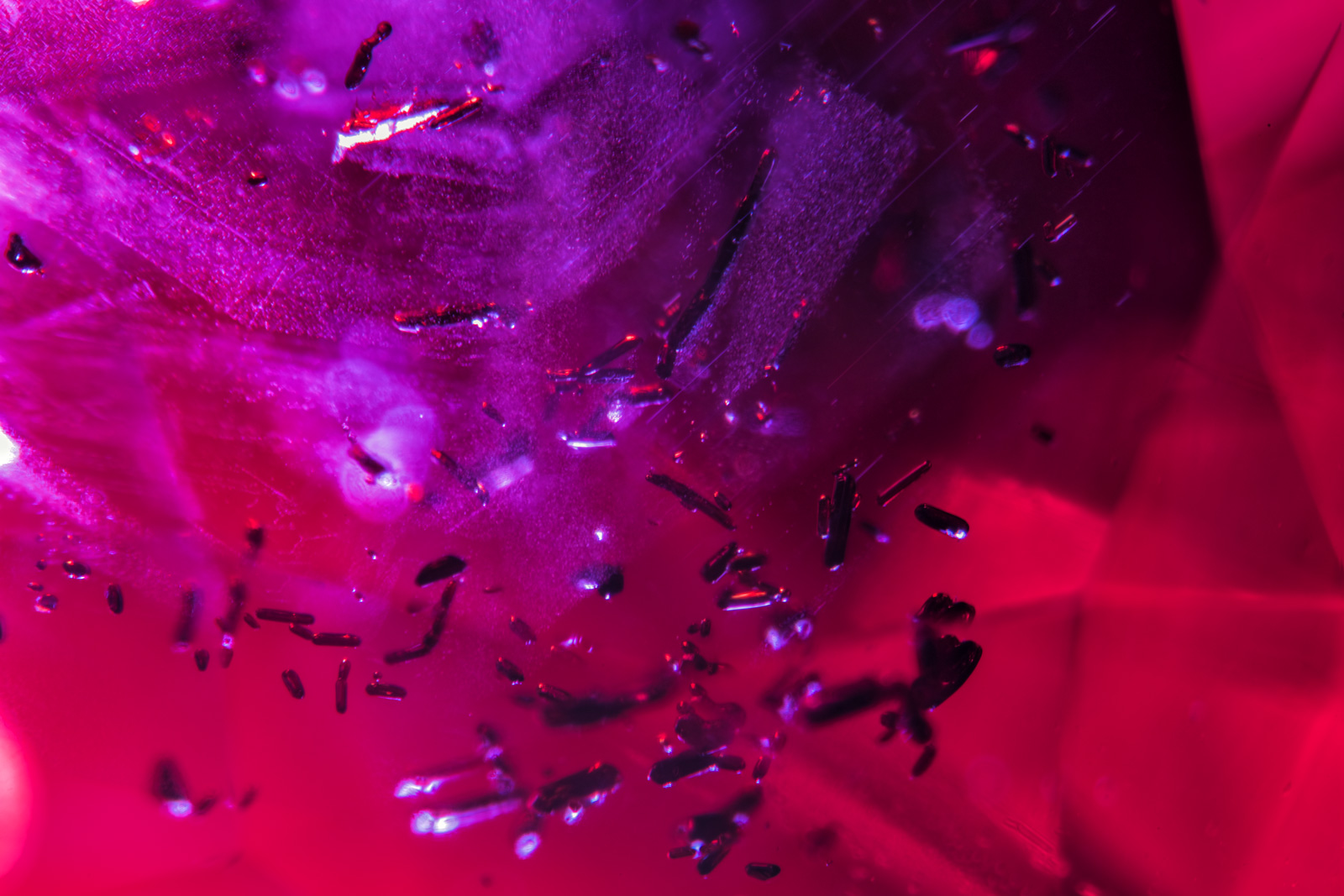 Perhaps the most distinctive inclusion feature of these new rubies from Madagascar is the dark red to black rods of what appears to be primary rutile. Also note the zoned cloud of exsolved particles. Photo: R.W. Hughes/Lotus Gemology.
Perhaps the most distinctive inclusion feature of these new rubies from Madagascar is the dark red to black rods of what appears to be primary rutile. Also note the zoned cloud of exsolved particles. Photo: R.W. Hughes/Lotus Gemology.
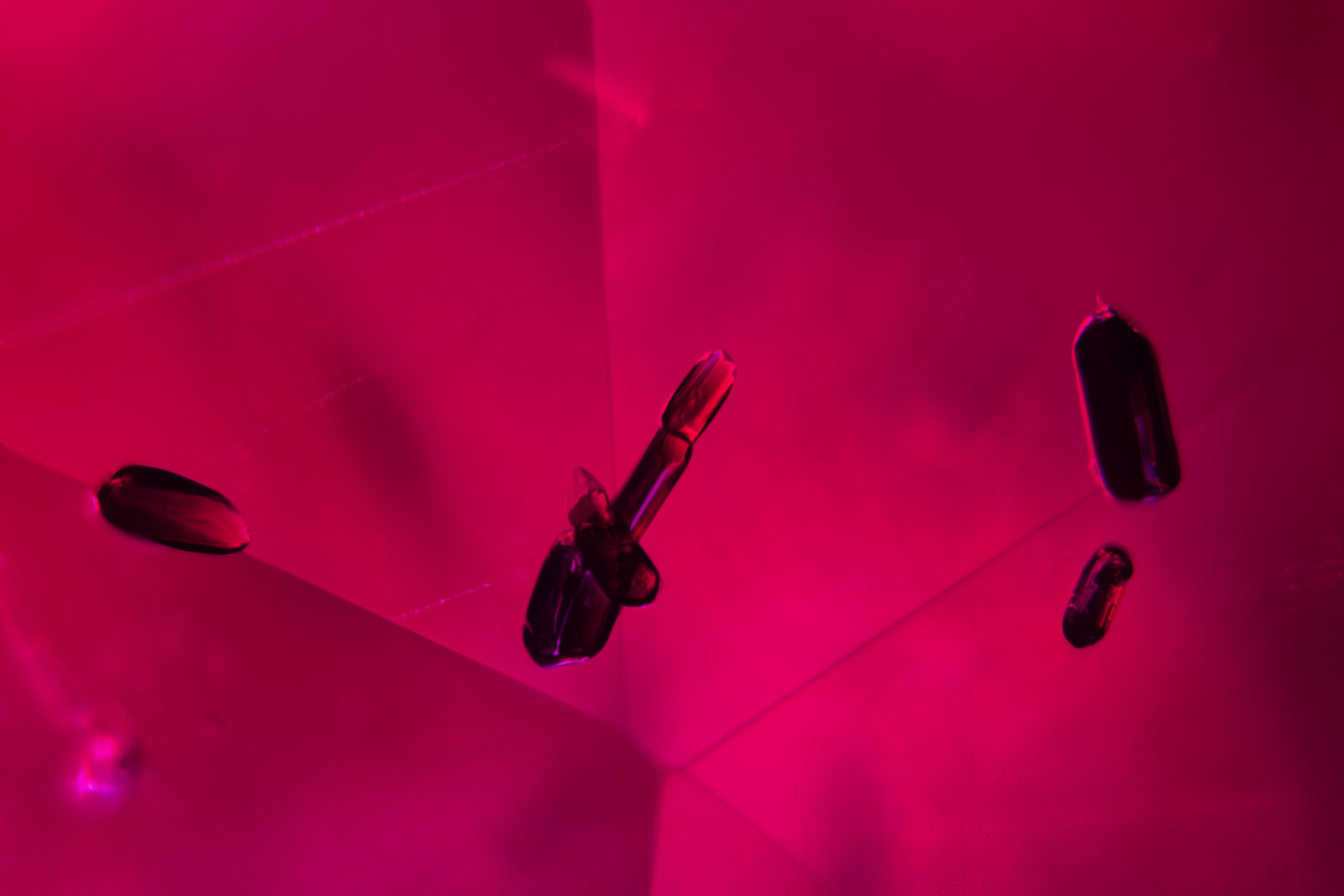 A closer look at the dark red to black rods of primary rutile. Photo: R.W. Hughes/Lotus Gemology.
A closer look at the dark red to black rods of primary rutile. Photo: R.W. Hughes/Lotus Gemology.
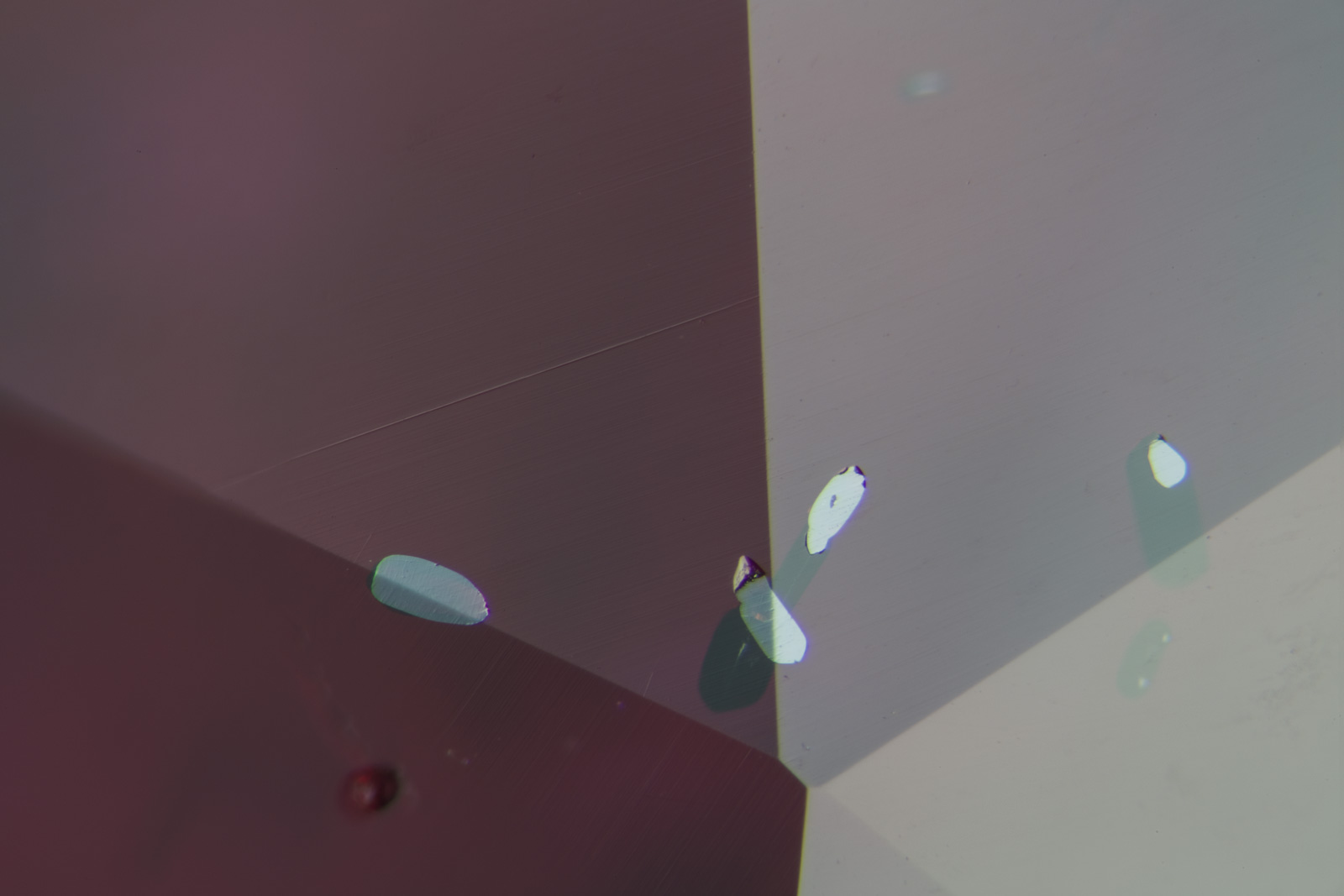 In reflected light, the metallic luster of the primary rutile stands in contrast to that of the surrounding ruby where the rutile is cut through on the surface. Photo: R.W. Hughes/Lotus Gemology.
In reflected light, the metallic luster of the primary rutile stands in contrast to that of the surrounding ruby where the rutile is cut through on the surface. Photo: R.W. Hughes/Lotus Gemology.
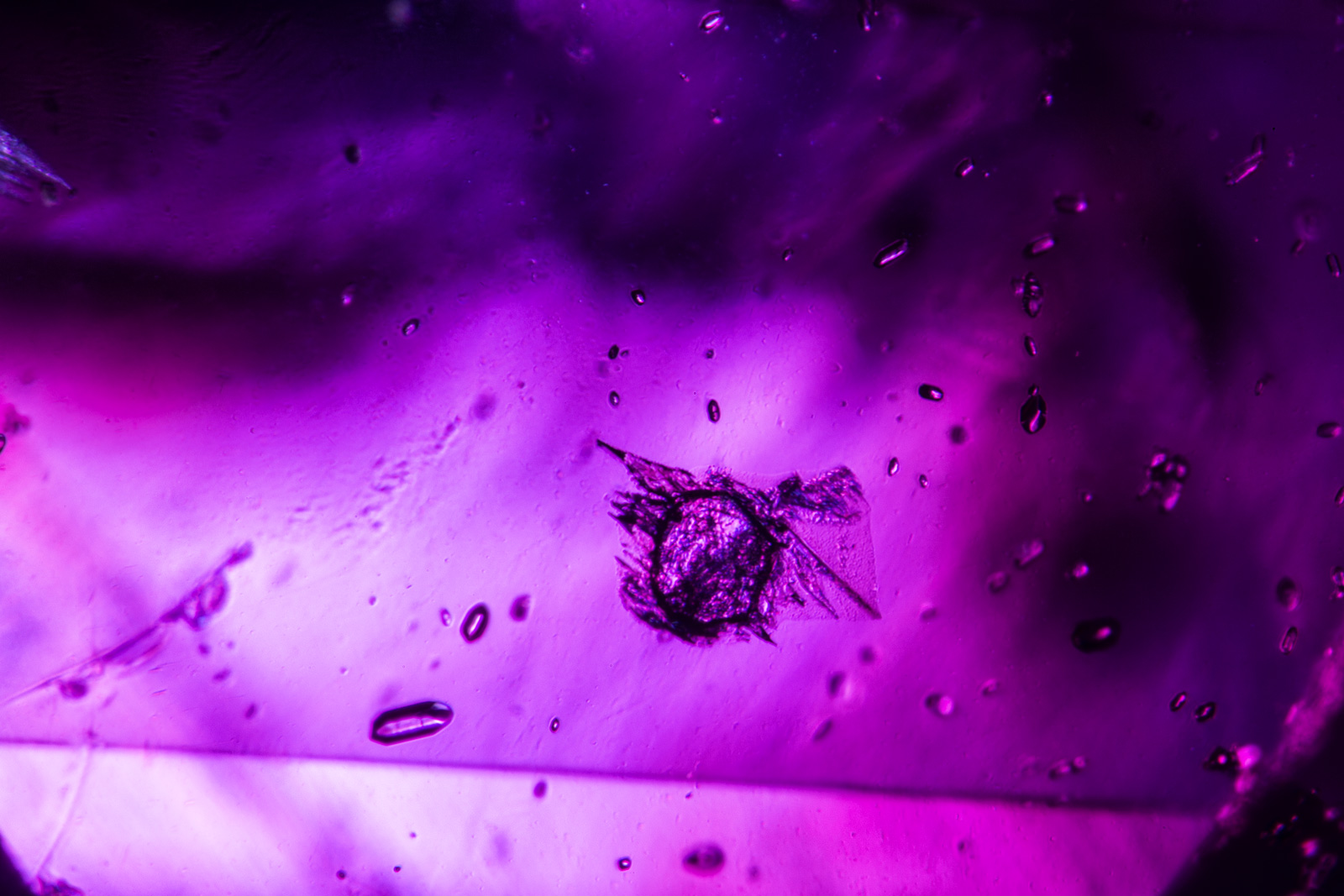 A crystal of what appears to be mica hovers over a backdrop filled with rounded crystals of what are probably zircon in this ruby from the new Madagascar find. Photo: R.W. Hughes/Lotus Gemology.
A crystal of what appears to be mica hovers over a backdrop filled with rounded crystals of what are probably zircon in this ruby from the new Madagascar find. Photo: R.W. Hughes/Lotus Gemology.
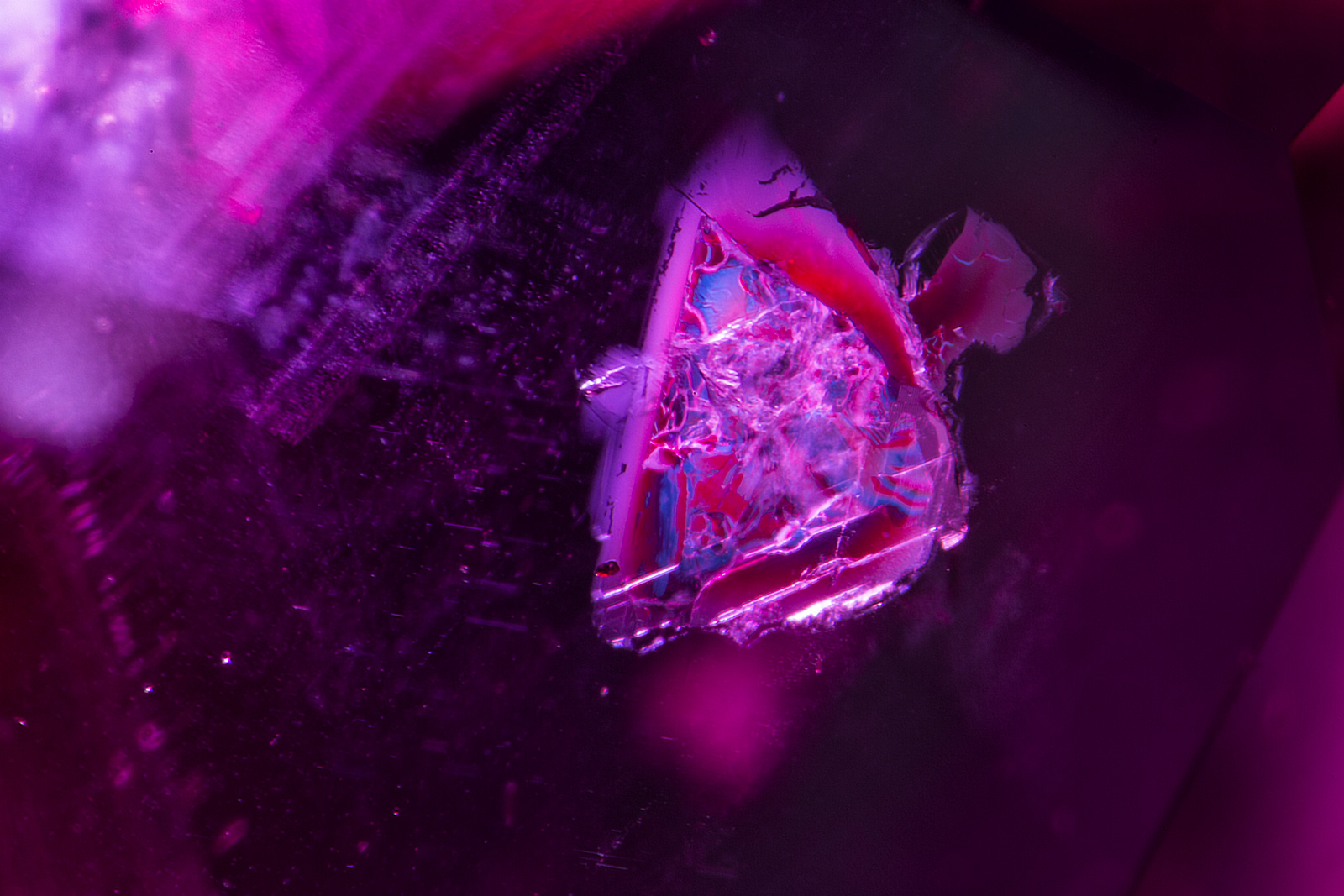 Another crystal of what appears to be mica in a ruby from the new Madagascar find. Photo: R.W. Hughes/Lotus Gemology.
Another crystal of what appears to be mica in a ruby from the new Madagascar find. Photo: R.W. Hughes/Lotus Gemology.
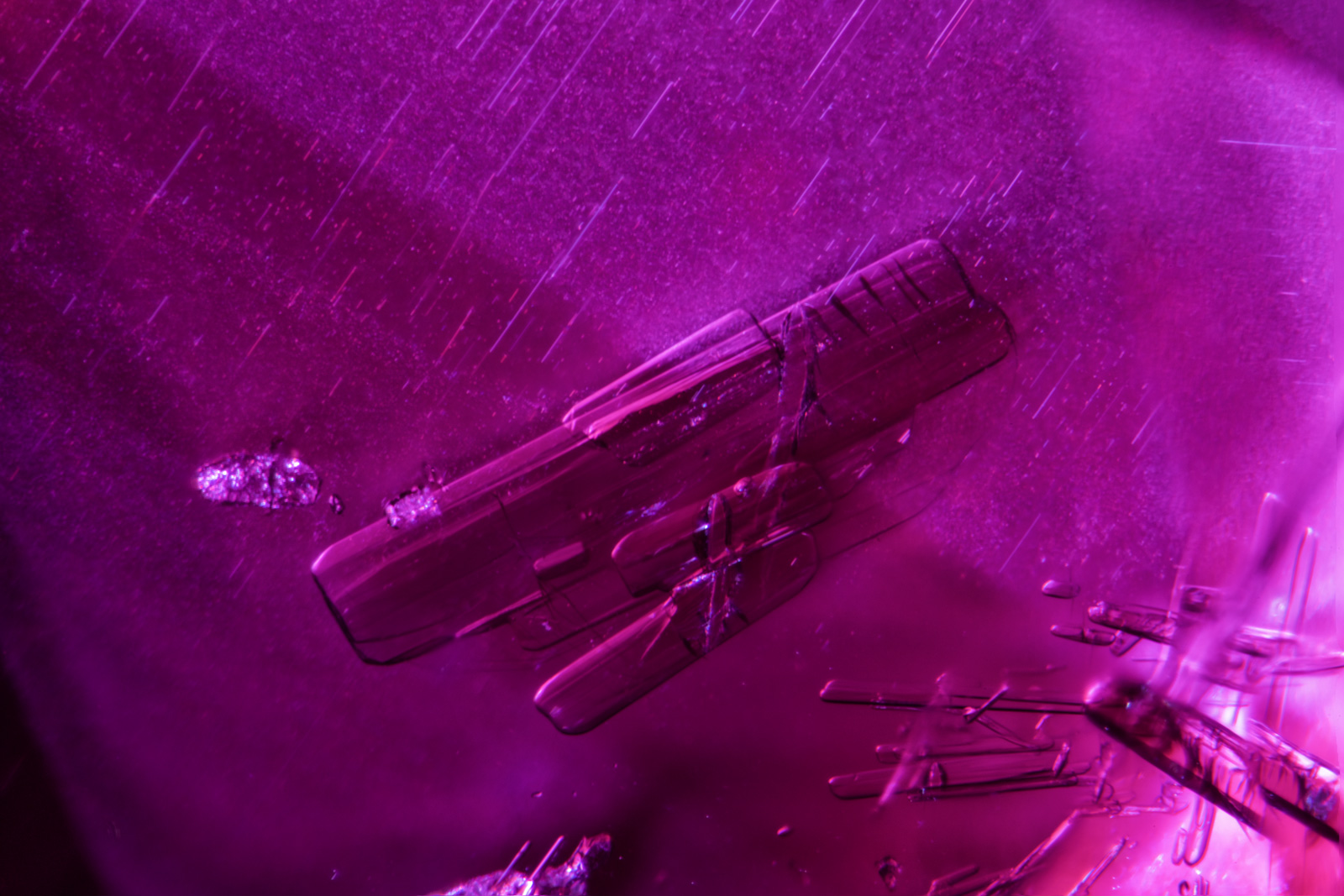 Rods of what are most likely amphibole in one of the new Madagascar rubies. Photo: R.W. Hughes/Lotus Gemology.
Rods of what are most likely amphibole in one of the new Madagascar rubies. Photo: R.W. Hughes/Lotus Gemology.
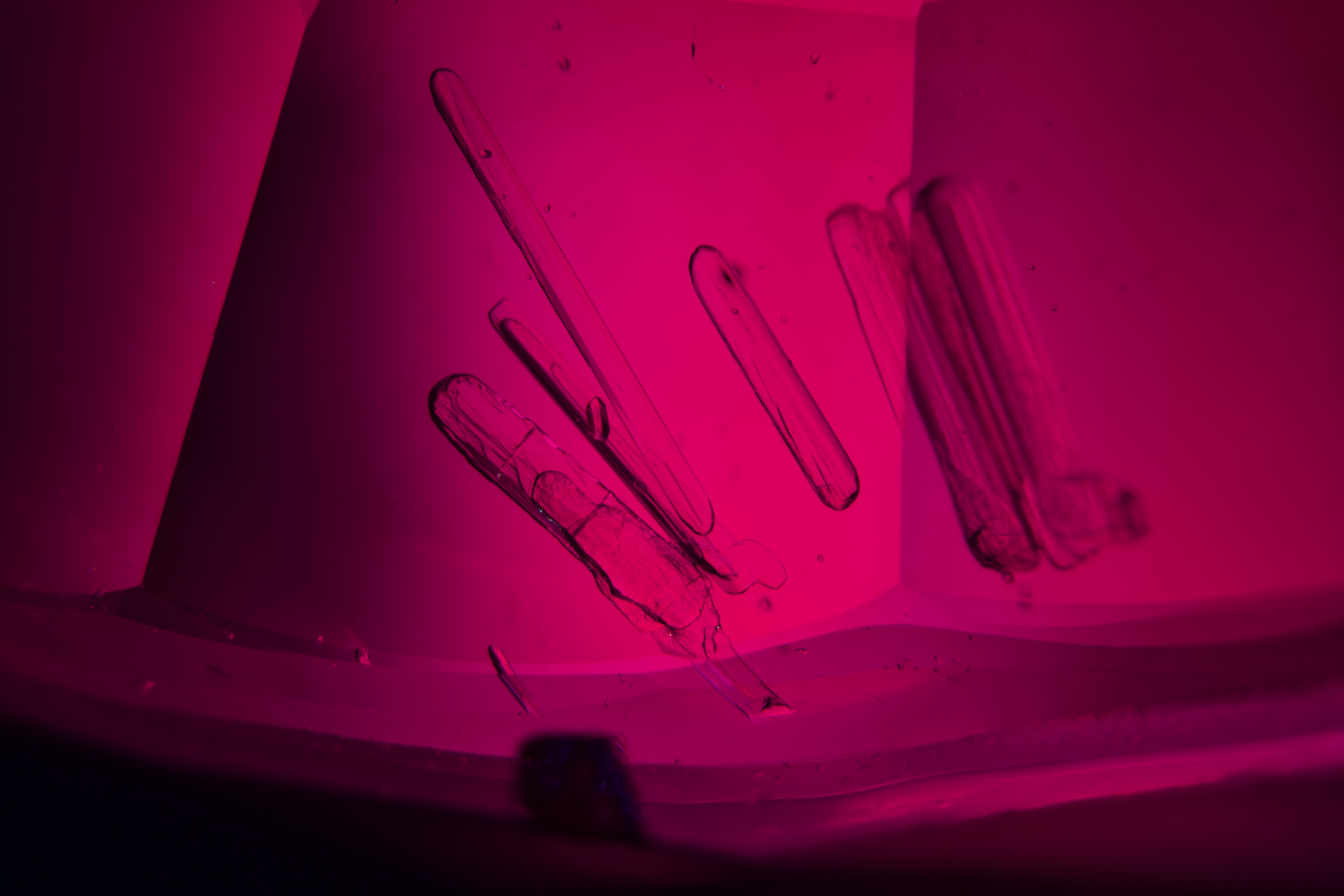 Again, rods of what are most likely amphibole in one of the new Madagascar rubies. Photo: R.W. Hughes/Lotus Gemology.
Again, rods of what are most likely amphibole in one of the new Madagascar rubies. Photo: R.W. Hughes/Lotus Gemology.
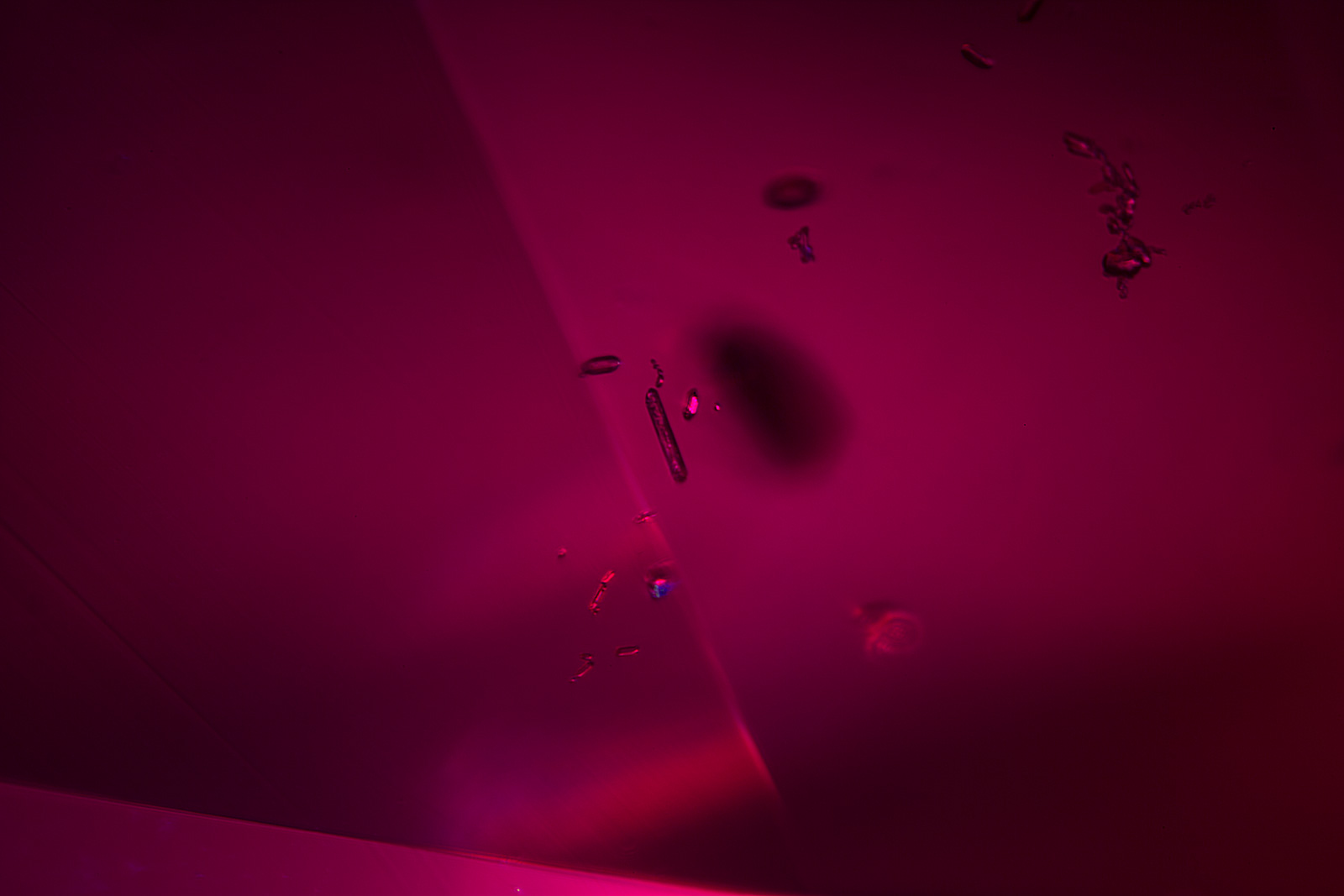 Small rounded crystals and clusters of what is probably zircon in one of the new Madagascar rubies. These crystals are common in Madagascar rubies and sapphires from many localities and will allow separation from rubies from Mozambique. Photo: R.W. Hughes/Lotus Gemology.
Small rounded crystals and clusters of what is probably zircon in one of the new Madagascar rubies. These crystals are common in Madagascar rubies and sapphires from many localities and will allow separation from rubies from Mozambique. Photo: R.W. Hughes/Lotus Gemology.
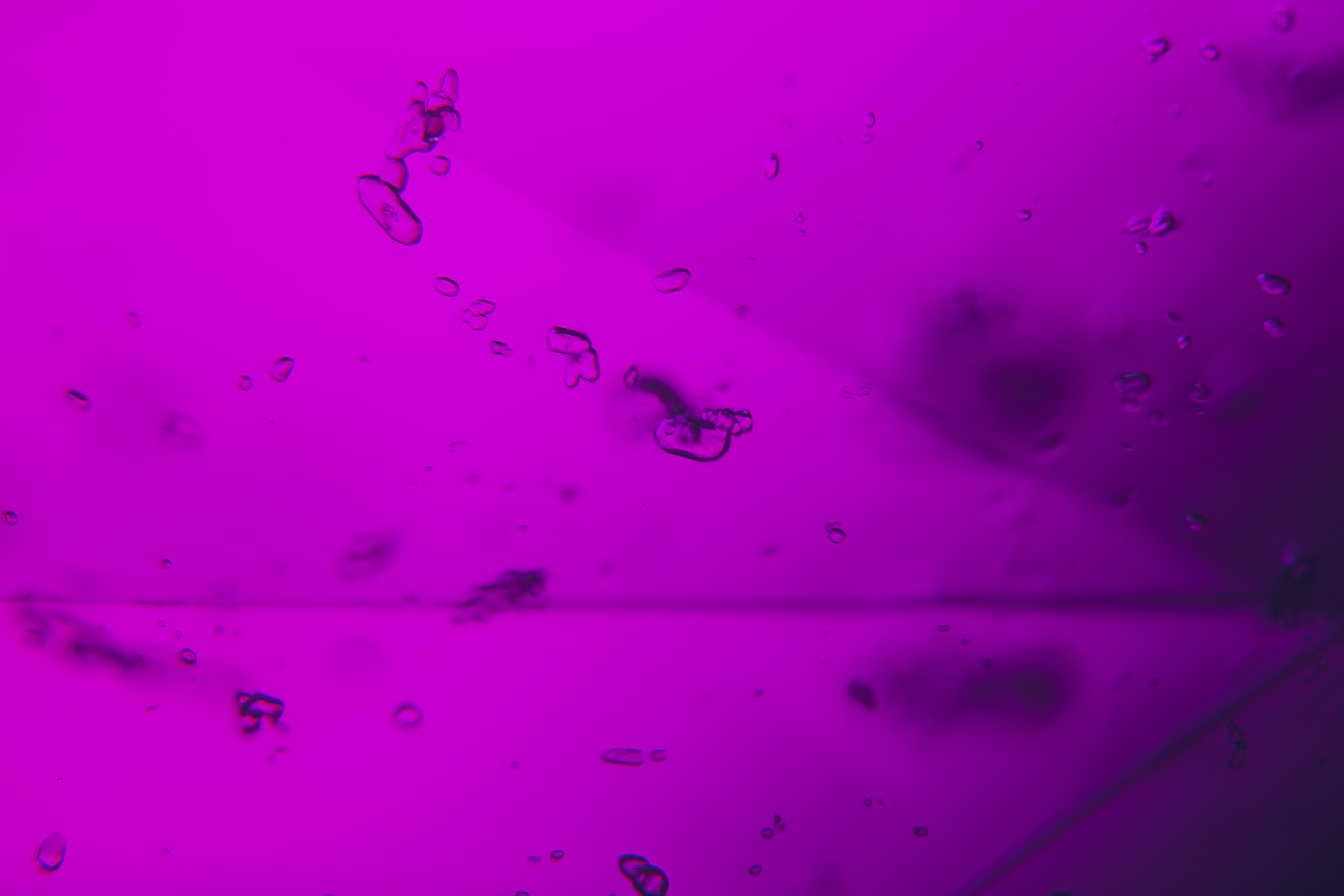 Another example of small rounded crystals and clusters of what is probably zircon. These crystals are common in Madagascar rubies and sapphires from many localities and will allow separation from rubies from Mozambique. Photo: E. Billie Hughes/Lotus Gemology.
Another example of small rounded crystals and clusters of what is probably zircon. These crystals are common in Madagascar rubies and sapphires from many localities and will allow separation from rubies from Mozambique. Photo: E. Billie Hughes/Lotus Gemology.
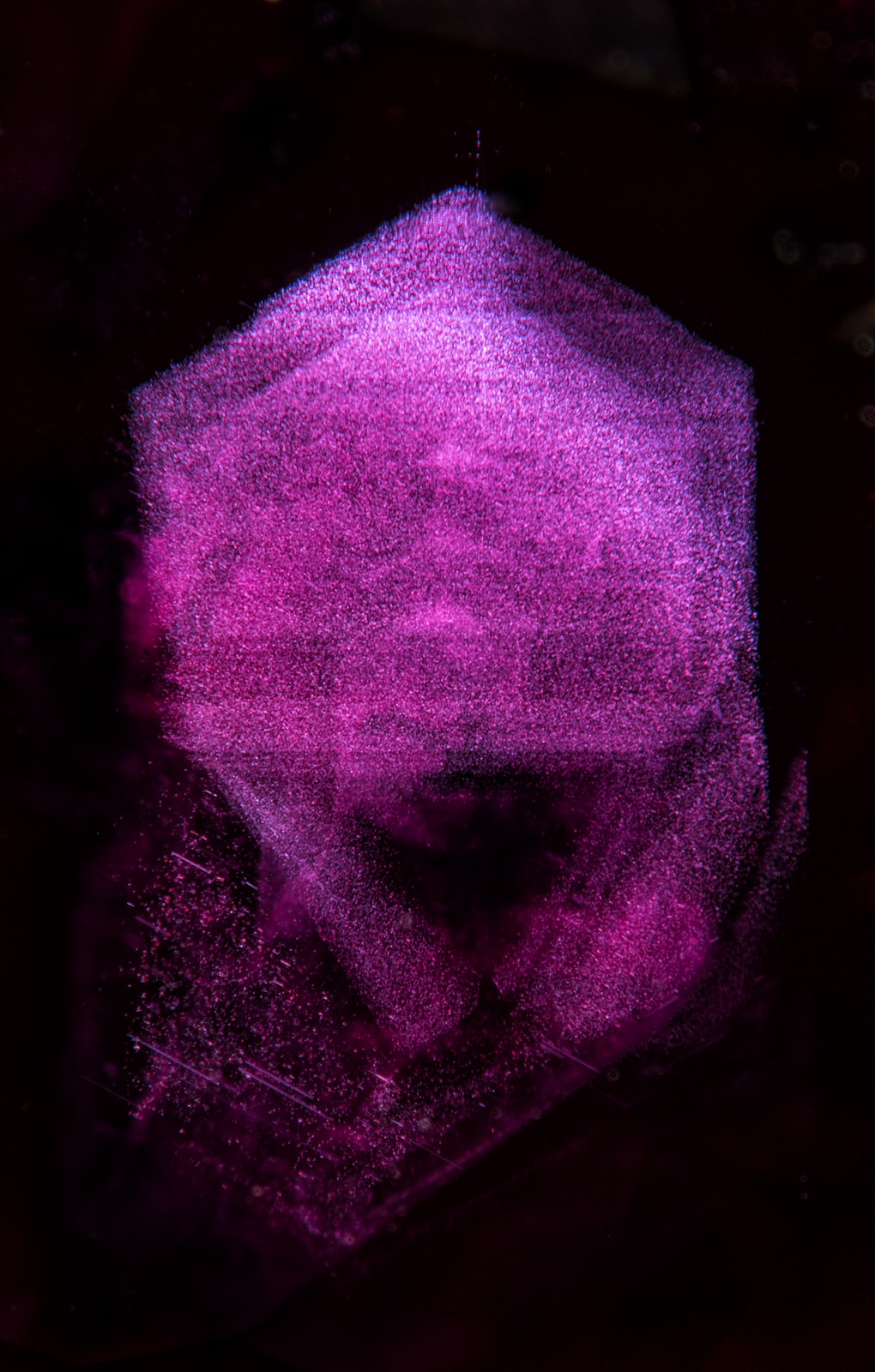 A high percentage of the rubies from the new find examined contained hexagonal clouds of exsolved particles and rutile silk. Photo: R.W. Hughes/Lotus Gemology.
A high percentage of the rubies from the new find examined contained hexagonal clouds of exsolved particles and rutile silk. Photo: R.W. Hughes/Lotus Gemology.
 Polysynthetic twinning was found in many of these new Madagascar rubies. Photo: E. Billie Hughes/Lotus Gemology.
Polysynthetic twinning was found in many of these new Madagascar rubies. Photo: E. Billie Hughes/Lotus Gemology.
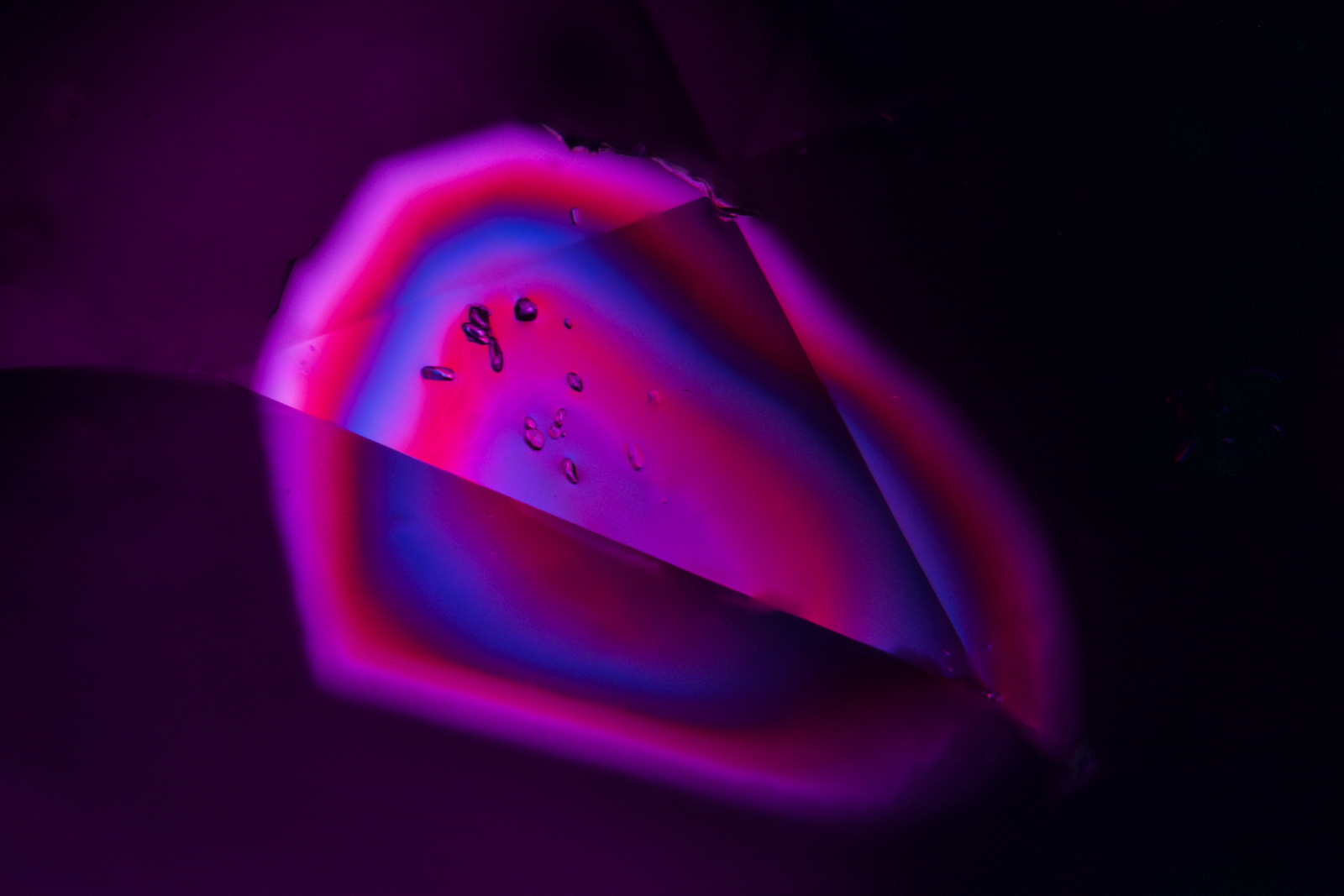 A single twin plane viewed between crossed polars provides a spectacular backdrop for several rounded zircon crystal grains. Photo: E. Billie Hughes/Lotus Gemology.
A single twin plane viewed between crossed polars provides a spectacular backdrop for several rounded zircon crystal grains. Photo: E. Billie Hughes/Lotus Gemology.
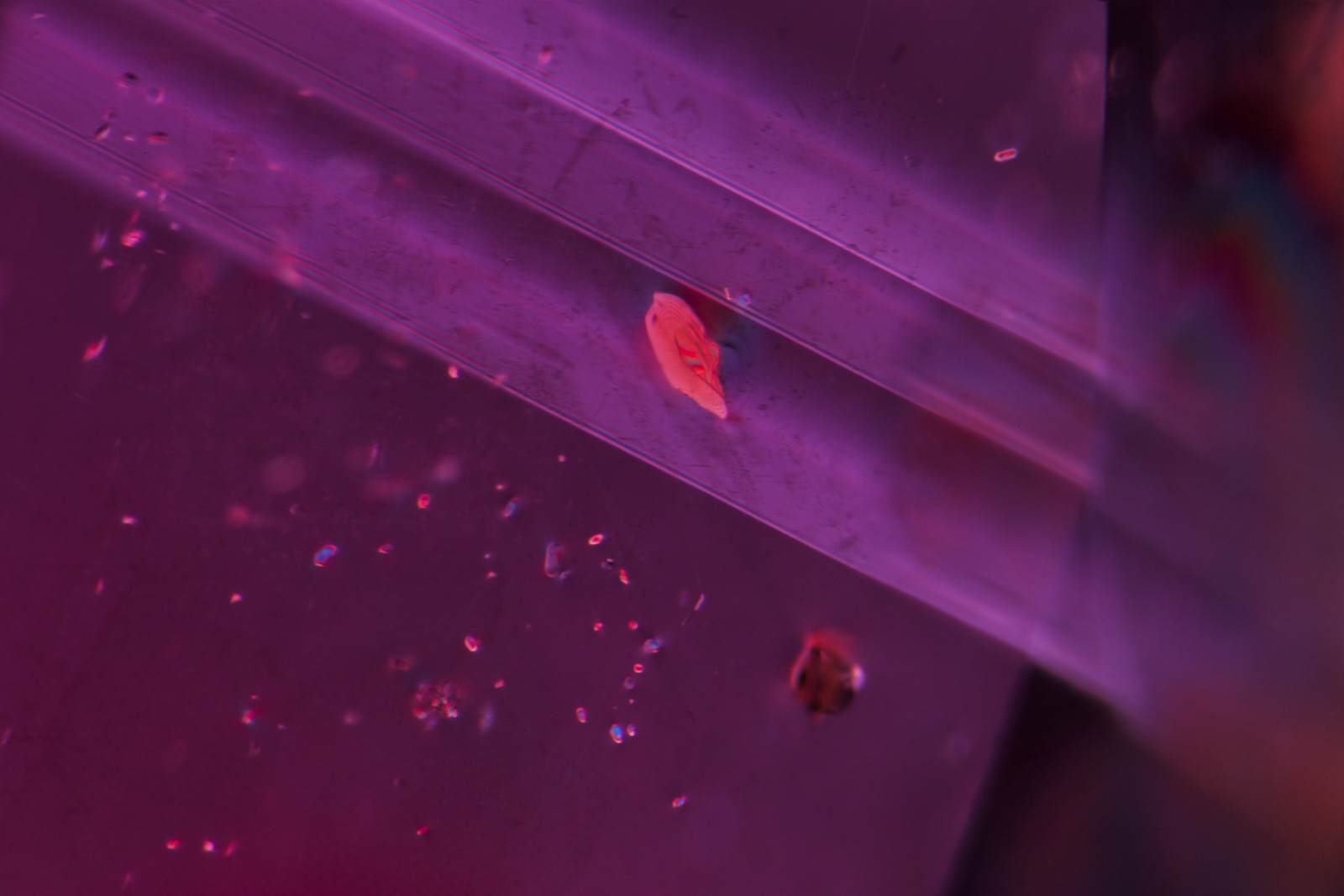 Two orange crystals of what is probably monazite float amidst polysynthetic twin planes in a new Madagascar ruby. Photo: R.W. Hughes/Lotus Gemology; crossed polars.
Two orange crystals of what is probably monazite float amidst polysynthetic twin planes in a new Madagascar ruby. Photo: R.W. Hughes/Lotus Gemology; crossed polars.
 Orange crystals (probably monazite) with small zircons in the background in this Madagascar ruby. Photo: R.W. Hughes/Lotus Gemology; transmitted light.
Orange crystals (probably monazite) with small zircons in the background in this Madagascar ruby. Photo: R.W. Hughes/Lotus Gemology; transmitted light.
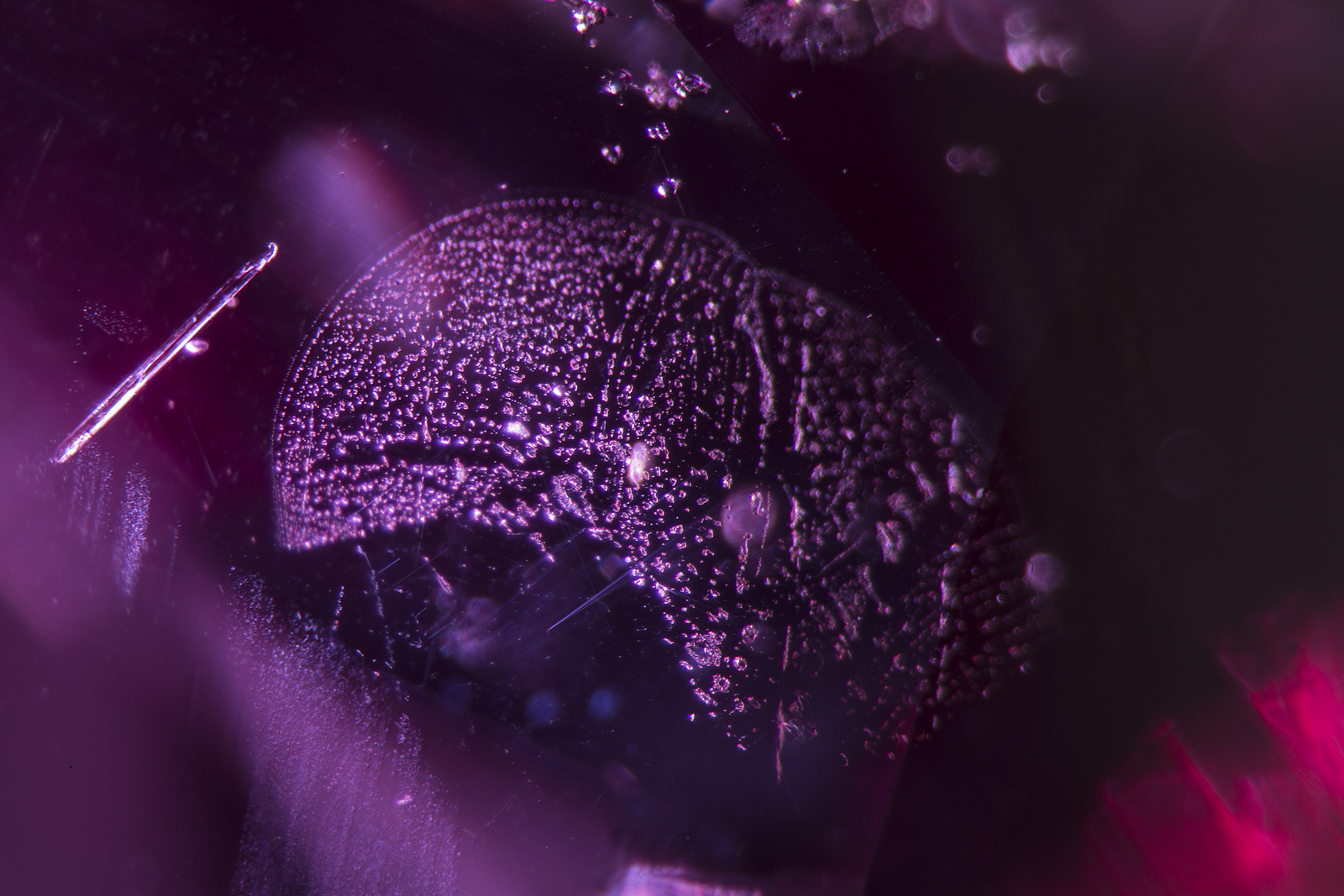 A slender amphibole rod perches next to a secondary healed fissure (’fingerprint’) in this untreated ruby from Andilamena, Madagascar. Photo: R.W. Hughes/Lotus Gemology.
A slender amphibole rod perches next to a secondary healed fissure (’fingerprint’) in this untreated ruby from Andilamena, Madagascar. Photo: R.W. Hughes/Lotus Gemology.
Visible Spectra
The visible spectra were typical for dark red ruby, with the deepest colors showed virtually no transmission below the ruby doublet at 468.5 and 476.5 nm. The somewhat more open colors showed a corresponding slight increase in transmission below 468.5 nm.
Infrared Spectra
Fourier-Transform Infrared Spectroscopy (FTIR) was performed on 38 rubies submitted for testing. As is common with rubies from other sources, the 3309 peak was present to some degree in virtually all samples. At the same time, the 3232 peak, which is often a strong indication of artificial heat treatment, was absent. This, along with the inclusions, suggested that all the stones submitted had not been subjected to heat treatment. Some specimens showed a large IR hump, which can probably be attributed to the inclusions of exsolved rutile needles and particles.
Typical infrared spectra for the new Madagascar rubies. Most showed a weak to moderate 3309 cm-1 peak. Stones with lots of silk often showed a large hump surrounding that peak. Click on the images for a larger photo.
| Property | Results1 |
|---|---|
| Color | Hue: Red; Saturation: Vivid to intense; Tone: Deep to medium deep; most stones fell into the "Royal Red" Lotus Gemology color type. One stone out of 38 pieces (a 1 ct stone) fell into the Lotus "Pigeon's Blood" color type. Light blue and greenish blue sapphires have also been reported from the same locality. |
| Refractive Index | 1.766–1.770 (0.008); uniaxial (–)2 |
| Polariscope Reaction | Doubly refractive, uniaxial interference figure |
| Specific Gravity (Hydrostatic) | 3.95–4.012 |
| UV Fluorescence | LW (366 nm): Medium to strong red SW (254 nm): Very weak to weak red |
| Visible Spectrum | Strong Cr spectrum with moderate to low violet transmission |
| Infrared Spectrum | Weak to moderate 3309 cm-1 peak. Stones with lots of silk often showed a large hump surrounding that peak. |
| Pleochroism | Moderate to weak. O-ray: Purplish red to red; E-ray: Reddish orange to orangish red |
| Inclusions |
Natural inclusions such as:
|
| 1 Based on the testing of 38 stones weighing from 1.04 to 7.16 ct. 2 Based on the testing of 12 stones |
|
Conclusion: When smoke becomes fire
This new discovery of ruby in Madagascar is a classic example of how gem exploration and production is not necessarily a linear process, but instead moves in fits and starts. Witness Colombia's Chivor emerald mines. Known and worked in pre-Columbian times, the deposit was also exploited during the early Spanish colonial period. And then the mines were "lost," only to be rediscovered by Peter Rainier about 1920 (Rainier, 1931).
Similarly, America's Newry Maine tourmaline mines were heavily exploited in the late 19th century, and then abandoned. In 1972, mineral collectors struck gold, uncovering an incredibly rich pocket at this "exhausted" locale (Bancroft, 1984).
In the case of Madagascar's Moramanga ruby mines, the initial production included "polychrome" sapphire and low-grade ruby that, at the time of the lead author's 2005 visit, was used for glass filling. Fast forward to 2015. Miners unearth material in the same vicinity that is of far better quality. Suddenly smoke becomes fire and this incredible island is once again bleeding red.
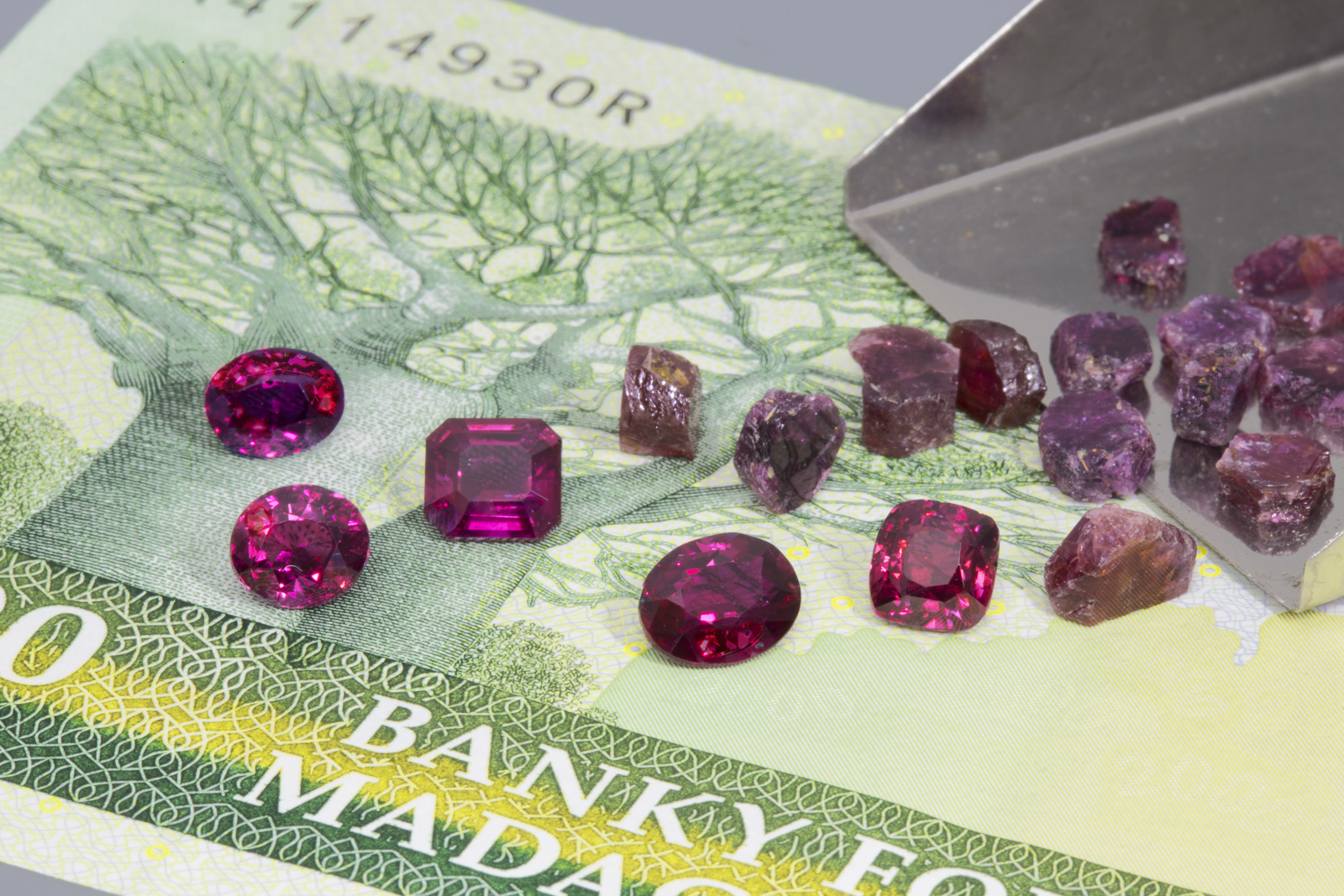 Faceted Madagascar rubies from the 2015 find, along with rough rubies from Moramanga collected by the author in 2005. The faceted stones are between 1.2 and 1.3 ct each. Photo: Wimon Manorotkul/Lotus Gemology.
Faceted Madagascar rubies from the 2015 find, along with rough rubies from Moramanga collected by the author in 2005. The faceted stones are between 1.2 and 1.3 ct each. Photo: Wimon Manorotkul/Lotus Gemology.

About the Authors
Richard W. Hughes is one of the world’s foremost experts on ruby and sapphire. The author of many books and over 170 articles, his writings and photographs have appeared in a diverse range of publications, and he has received numerous industry awards. Co-winner of the 2004 Edward J. Gübelin Most Valuable Article Award from Gems & Gemology magazine, the following year he was awarded a Richard T. Liddicoat Journalism Award from the American Gem Society. In 2010, he received the Antonio C. Bonanno Award for Excellence in Gemology from the Accredited Gemologists Association. The Association Française de Gemmologie (AFG) in 2013 named Richard as one of the Fifty most important figures that have shaped the history of gems since antiquity. In 2016, Richard was awarded a visiting professorship at Shanghai's Tongji University. 2017 saw the publication of Richard and his wife and daughter's Ruby & Sapphire • A Gemologist's Guide, arguably the most complete book ever published on a single gem species and the culmination of four decades of work in gemology. In 2018, Richard was named Photographer of the Year by the Gem-A, recognizing his photo of a jade-trading market in China, while in 2020, he was elected to the board of directors of the Accredited Gemologists Association and was appointed to the editorial review board of Gems & Gemology and The Australian Gemmologist magazine. In 2022, Richard published Jade • A Gemologist's Guide, while 2024 brought Broken Bangle • The Blunder-Besmirched History of Jade Nomenclature. His jade trilogy was completed in 2025 with his translation of Heinrich Fischer's Nephrite and Jadeite.
Wimon Manorotkul has been involved with gems and gemology since 1979, as a lab gemologist, instructor and photographer. She is an Accredited Gemologist from Bangkok's Asian Institute of Gemological Sciences and for many years directed their lab. Wimon also qualified as a Fellow (with honors) of the Gemmological Association of Great Britain. A skilled gem photographer, her images have been featured in books and magazines around the world, particularly Ruby & Sapphire: A Collector's Guide, along with Ruby & Sapphire: A Gemologist's Guide and Inside Out | GEM• ology Through Lotus-Colored Glasses. Wimon not only photographs gems, jewelry and mineral specimens, but is also an expert photomicrographer. In 2013, she founded Lotus Gemology with her husband, Richard Hughes, and daughter, E. Billie Hughes.
E. Billie Hughes visited her first gem mine (in Thailand) at age two and by age four had visited three major sapphire localities in Montana. A 2011 graduate of UCLA, she qualified as a Fellow of the Gemmological Association of Great Britain (FGA) in 2013. An award winning photographer and photomicrographer, she has won prizes in the Nikon Small World and Gem-A competitions, among others. Her writing and images have been featured in books, magazines, and online by Forbes, Vogue, National Geographic, and more. In 2019 the Accredited Gemologists Association awarded her their Gemological Research Grant. Billie is a sought-after lecturer and has spoken around the world to groups including Cartier and Van Cleef & Arpels. In 2020 Van Cleef & Arpels’ L’École School of Jewellery Arts staged exhibitions of her photomicrographs in Paris and Hong Kong.
Acknowledgments
The authors would like to thank Por Kuang Tang of PK Gems (Bangkok), Tom Cushman of Richfield Investor Services (Madagascar), Daniel Sherf of Shoham (Bangkok), and Riccardo Bertoncelli (Madagascar) for their generous assistance with this article. RWH also thanks his favorite travel mates, Vincent Pardieu and Dana Schorr (r.i.p.), who accompanied him on his 2005 trip to Madagascar.
References & Further Reading
- Bancroft, P. (1984) Gem and Crystal Treasures. Fallbrook, CA, Western Enterprises/Mineralogical Record, 488 pp.
- Emmett, J.L., Scarratt, K. et al. (2003) Beryllium diffusion of ruby and sapphire. Gems & Gemology, Vol. 39, No. 2, Summer, pp. 84–135.
- Hughes, R.W., Pardieu, V. and Schorr, D. (2006) Sorcerers and Sapphires: A visit to Madagascar. The Guide, Jan.–Feb., Vol. 25, Issue 1, Part 1, pp. 1, 4–6.
- Leuenberger, A. (2001) Gem News International: The new ruby deposits in eastern Madagascar: Mining and production. Gems & Gemology, Vol. 37, No. 2, Summer, pp. 147–149.
- Pardieu, V. and Rakotosaona, N. (2012) Ruby and Sapphire Rush Near Didy, Madagascar (April–June 2012). GIA News from Research, October 14.
- Rainier, P.W. (1931) The Chivor-Somondoco emerald mines of Colombia. Transactions, AIME, Vol. 96, pp. 204–223.



